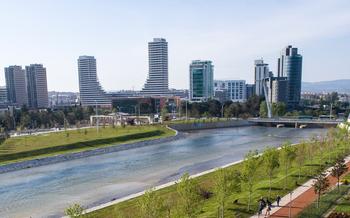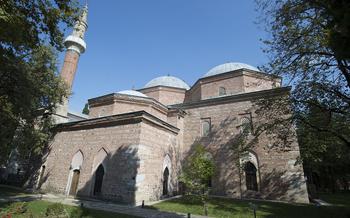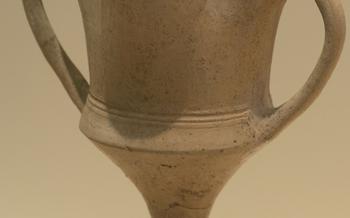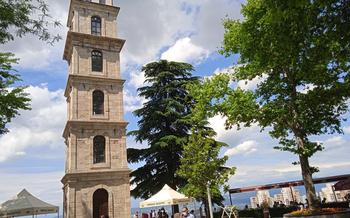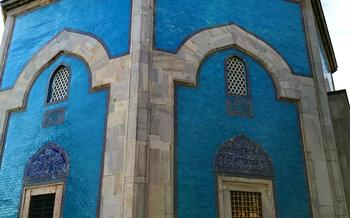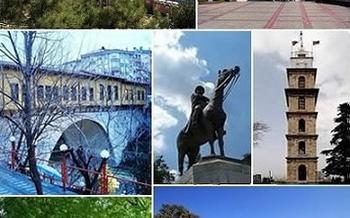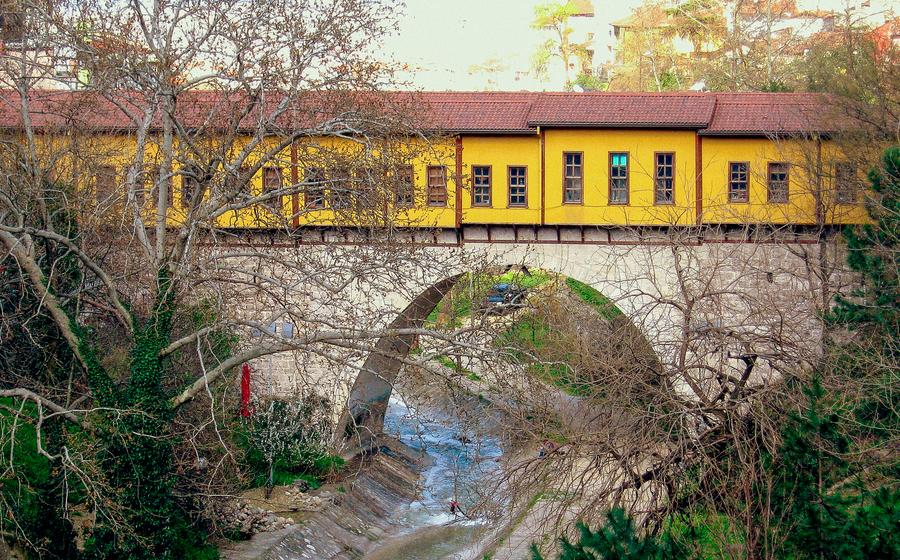
Irgandı Bridge
- Irgandı Bridge: A Historical Landmark in Bursa
- Location and Accessibility
- The Bridge's Design and Architecture
- Historical Significance
- Visiting the Irgandı Bridge
- Views from the Bridge
- Surrounding Area
- Restoration and Preservation
- The Bridge in Literature and Arts
- Local Customs and Traditions
- Local Cuisine and Delicacies
- Shopping and Souvenirs
- Insider Tip: Unveiling the Hidden Gems of Irgandı Bridge
Irgandı Bridge: A Historical Landmark in Bursa
Located in the heart of Bursa, Turkey, the Irgandı Bridge stands as a testament to the city's rich history and architectural prowess. Built in 1442 during the reign of Ottoman Sultan Murad II, this iconic bridge has witnessed centuries of trade, commerce, and cultural exchange. Its unique design, intricate carvings, and historical significance make it a must-visit attraction for anyone exploring Bursa's Ottoman heritage.
The Irgandı Bridge is a remarkable example of Ottoman engineering and craftsmanship. Its single arch spans the Gökdere River, connecting the bustling commercial district to the historic quarter. The bridge's unique design allows for efficient water flow, preventing flooding during heavy rains. The intricate carvings and decorations adorning the bridge's exterior showcase the artistry and attention to detail characteristic of Ottoman architecture.
As a symbol of Bursa's Ottoman heritage, the Irgandı Bridge holds a special place in the hearts of locals and visitors alike. Its enduring presence serves as a reminder of the city's role as a major trading center during the Ottoman Empire. Today, the bridge continues to be a vibrant hub of activity, with locals and tourists crossing it daily to experience Bursa's rich history and vibrant culture.
Location and Accessibility
The Irgandı Bridge is strategically situated in the heart of Bursa, spanning the Nilüfer River and connecting the historical district of Tophane to the modern city center. Its prime location makes it easily accessible by various means of transportation.
To reach the bridge by public transport, visitors can hop on the tramvay (tram) line and get off at the Irgandı stop. Alternatively, numerous bus lines, including the 1/K, 2/K, 4/K, and 13/K, have stops within walking distance of the bridge.
For those traveling by car, the bridge is conveniently accessible via major roads such as Atatürk Caddesi and Sırrıpaşa Caddesi. Ample parking spaces are available in the vicinity of the bridge, ensuring a hassle-free visit.
Moreover, the Irgandı Bridge is wheelchair accessible, featuring ramps and elevators that allow visitors with disabilities to fully explore and appreciate this historic landmark.
The Bridge's Design and Architecture
The Irgandı Bridge is an architectural masterpiece that showcases the ingenuity and skill of Ottoman engineers. The bridge is constructed using stone and brick, with a total length of approximately 90 meters and a width of 4 meters. It features seven arches, each of which is supported by massive stone piers. The arches are pointed, which is a common feature of Ottoman architecture and allows for the distribution of weight more efficiently.
The bridge's most striking feature is its intricate carvings and decorations. The exterior of the bridge is adorned with beautiful Islamic calligraphy, geometric patterns, and floral motifs. These decorations are carved into the stone and brick, creating a visually stunning effect. The bridge's parapets are also decorated with small turrets, which add to its overall aesthetic appeal.
The Irgandı Bridge is a testament to the skill and artistry of Ottoman builders. It is a unique and beautiful example of Islamic architecture, and it is one of the most iconic landmarks in Bursa. The bridge's design and architecture have been compared to other famous Ottoman bridges, such as the Mostar Bridge in Bosnia and Herzegovina and the Rialto Bridge in Venice, Italy. However, the Irgandı Bridge stands out for its unique features and its historical significance as a symbol of Bursa's Ottoman heritage.
Historical Significance
The Irgandı Bridge stood as a vital artery of commerce and trade during the Ottoman Empire's reign. Caravans laden with precious goods traversed its length, linking Bursa to the far-flung corners of the empire. The bridge facilitated the exchange of diverse commodities, from exquisite silks and spices to precious metals and gemstones. This vibrant trade not only enriched Bursa's coffers but also transformed it into a thriving commercial hub, a melting pot of cultures and traditions.
Beyond its economic significance, the Irgandı Bridge served as a strategic link, connecting Bursa to the surrounding regions. It provided a safe passage for armies, pilgrims, and travelers, fostering communication and cultural exchange. The bridge's strategic location also made it a witness to numerous historical events, including battles, sieges, and triumphant processions. Each footstep that echoed across its stones carried the weight of history, weaving a rich tapestry of stories that continue to captivate visitors to this day.
Visiting the Irgandı Bridge
For the most enjoyable experience, visit the Irgandı Bridge during the spring or autumn months when the weather is pleasant. Allow at least an hour to fully explore the bridge, taking your time to admire its intricate details and soak in the panoramic views. Guided tours are available for those who want to learn more about the bridge's history and significance. Alternatively, you can opt for self-guided exploration, using information panels and brochures to enhance your visit. To capture the perfect photos, arrive early in the morning or late in the afternoon when the lighting is optimal. Use a wide-angle lens to capture the bridge's grandeur and experiment with different angles to create unique compositions.
Views from the Bridge
When it comes to breathtaking vistas, the Irgandı Bridge doesn't disappoint. From its elevated position, visitors are treated to panoramic views of Bursa city, a tapestry of historical landmarks, modern skyscrapers, and lush green hills. The gaze is inevitably drawn to Uludağ (Mount Olympus), a majestic peak that dominates the horizon, its snow-capped summit shimmering in the sunlight.
An observation deck on the bridge provides unobstructed views of the surrounding landscape, making it a paradise for photography enthusiasts. Capture the city's skyline, with its iconic mosques and minarets piercing the sky, or zoom in on the intricate details of the bridge's architecture. The bridge itself becomes a subject of interest, its graceful arches and ornate carvings standing out against the backdrop of the city.
Whether you're an avid photographer or simply someone who appreciates stunning scenery, the Irgandı Bridge offers a feast for the eyes. Take a moment to soak in the beauty of Bursa from this unique vantage point, and create memories that will last a lifetime.
Surrounding Area
The Irgandı Bridge is not just a historical landmark but also a gateway to exploring Bursa's rich cultural tapestry. In the immediate vicinity of the bridge, visitors can immerse themselves in a vibrant blend of history, tradition, and modern-day attractions.
A short stroll from the bridge takes you to the bustling Koza Han, a traditional Turkish bazaar dating back to the 15th century. Here, you can haggle for unique souvenirs, textiles, and handicrafts that reflect Bursa's rich cultural heritage. The air is filled with the sounds of merchants calling out their wares, the aroma of freshly brewed Turkish coffee, and the lively chatter of locals going about their daily lives.
For those seeking culinary delights, the area surrounding the Irgandı Bridge offers a tantalizing array of local restaurants serving authentic Turkish cuisine. Indulge in mouthwatering kebabs, savory börek pastries, and the city's signature dish, İskender kebap, a succulent lamb dish served over crispy pide bread and topped with a velvety tomato sauce and melted butter.
Bursa is also home to several historical sites and attractions within easy reach of the Irgandı Bridge. The Ulu Mosque, just a few minutes' walk away, is a magnificent example of Ottoman architecture and a testament to the city's religious heritage. The Bursa Archaeological Museum, housed in a former caravanserai, showcases a fascinating collection of artifacts from the region's rich past.
For those seeking a respite from the hustle and bustle of city life, a visit to the nearby Muradiye Complex offers a tranquil oasis. This 15th-century complex, nestled amidst lush gardens, features a mosque, a medrese (Islamic school), and a türbe (mausoleum) of Sultan Murad II. The serene atmosphere and stunning views of Uludağ (Mount Olympus) make it an ideal spot for contemplation and relaxation.
Whether you're a history buff, a foodie, or simply seeking a unique and immersive cultural experience, the area surrounding the Irgandı Bridge offers something for everyone.
Restoration and Preservation
Over the centuries, the Irgandı Bridge has undergone several restoration and preservation efforts to maintain its historical integrity and structural stability. The first major restoration project was undertaken in the 19th century during the reign of Sultan Abdülhamid II. During this time, the bridge's foundations were reinforced, and its arches were repaired using traditional techniques.
In the 20th century, the bridge faced significant challenges due to increased traffic and environmental factors. In the 1970s, a comprehensive restoration project was initiated to address these issues. The project involved cleaning and repairing the bridge's stonework, replacing damaged sections, and implementing traffic restrictions to reduce the load on the bridge.
Preserving the bridge's historical authenticity was a top priority during the restoration process. Traditional materials and techniques were used to ensure that the bridge retained its original character. Skilled artisans and craftsmen worked meticulously to restore the bridge's intricate carvings and decorations, preserving its unique aesthetic appeal.
Today, the Irgandı Bridge stands as a testament to the successful efforts of its restoration and preservation. It remains a vital part of Bursa's urban fabric, serving as a reminder of the city's rich history and architectural heritage.
The Bridge in Literature and Arts
The Irgandı Bridge has served as a muse for many renowned Turkish poets, writers, and artists throughout history. In the realm of literature, the bridge has been immortalized in poems and prose, capturing its beauty, grandeur, and historical significance. Celebrated Turkish poet Ziya Gökalp penned moving verses dedicated to the bridge, paying tribute to its enduring spirit.
In the world of visual arts, the bridge has been a subject of fascination for painters and sketch artists. Renowned Turkish painter Şeker Ahmet Paşa created stunning watercolors depicting the bridge's intricate details and the vibrant life surrounding it. These artworks provide a glimpse into the bridge's past and the cultural heritage it represents.
Moreover, the bridge serves as a backdrop for various cultural events and festivals held in Bursa. The annual Bursa International Festival of Arts and Culture often features performances, exhibitions, and installations that incorporate the bridge as a central element, showcasing its unique charm and artistic potential.
Local Customs and Traditions
The Irgandı Bridge is not just a historical landmark but also a place deeply intertwined with local customs and traditions. It is believed to bring good luck to cross the bridge on foot, and many locals make a ritual of doing so every day. There are also ceremonies and rituals performed on or near the bridge, such as weddings, engagements, and prayers. These traditions reflect the cultural significance of the bridge and contribute to its unique charm.
One of the most fascinating customs associated with the Irgandı Bridge is the belief that it can grant wishes. Visitors often tie colorful ribbons or scarves to the bridge's railings, each representing a wish or prayer. These ribbons flutter in the wind, creating a vibrant display that symbolizes the hopes and dreams of those who have visited the bridge.
Local folklore tells tales of people who have had their wishes granted after tying a ribbon on the Irgandı Bridge. Some say that wishes related to love, marriage, or fertility are particularly likely to come true. These stories add to the mystique of the bridge and make it a popular destination for those seeking good fortune and blessings.
Local Cuisine and Delicacies
A visit to the Irgandı Bridge is not complete without sampling the local cuisine and delicacies that Bursa is famous for. The area surrounding the bridge is a culinary haven, with restaurants and cafes offering a wide range of traditional Turkish dishes and street food.
One of the must-try dishes in Bursa is Iskender kebab, a specialty consisting of thinly sliced döner meat served on a bed of pide bread, topped with tomato sauce, yogurt, and melted butter. Another local delicacy is Bursa pide, a type of flatbread filled with various toppings such as cheese, minced meat, or vegetables.
For those with a sweet tooth, Bursa offers an array of delectable desserts, including the famous şekerpare, a sweet pastry soaked in syrup, and güllaç, a layered dessert made with filo pastry and rose water.
Visitors can enjoy their meals while taking in the stunning views of the Irgandı Bridge from one of the many restaurants and cafes in the area. Whether indulging in a traditional Turkish breakfast, savoring a hearty lunch, or enjoying a sweet treat, the culinary experiences in Bursa are sure to enhance your visit to the bridge.
Shopping and Souvenirs
The area surrounding the Irgandı Bridge is a haven for shopaholics and souvenir enthusiasts. The bustling bazaars and markets offer a wide array of unique souvenirs and handicrafts that reflect Bursa's rich cultural heritage. From intricately designed carpets and textiles to hand-painted ceramics and jewelry, there's something for every taste and budget.
For those seeking authentic Turkish souvenirs, the covered bazaar near the bridge is a must-visit. Here, you can find an assortment of traditional Turkish delights such as lokum (Turkish delight), baklava, and Turkish coffee. You can also find a variety of spices, herbs, and teas that are unique to the region.
Bursa is also famous for its textiles, particularly its silk and cotton fabrics. The city's Grand Bazaar is a textile lover's paradise, offering a dazzling array of colorful fabrics, scarves, and shawls. Bargaining is expected and part of the shopping experience, so don't be afraid to haggle with the vendors to get the best prices.
If you're looking for more modern shopping options, there are several shopping malls and boutiques located in the city center. These malls offer a mix of local and international brands, as well as a variety of restaurants and cafes.
Whether you're looking for unique souvenirs, authentic Turkish handicrafts, or simply a great shopping experience, the area surrounding the Irgandı Bridge has something to offer everyone. So be sure to set aside some time to explore the local markets and shops during your visit to Bursa.
Insider Tip: Unveiling the Hidden Gems of Irgandı Bridge
Beyond the main tourist attractions surrounding the Irgandı Bridge, there are hidden gems waiting to be discovered. For those seeking a unique perspective, venture off the beaten path to find secret spots that offer breathtaking views of the bridge. These secluded corners provide the perfect opportunity to capture stunning photographs and appreciate the bridge's grandeur from a different angle.
To make your visit even more memorable, time your trip to coincide with local festivals or events held near the bridge. These celebrations offer a chance to immerse yourself in Bursa's vibrant culture and experience the bridge as a lively backdrop for traditional performances, music, and festivities.
To avoid the crowds and ensure a tranquil exploration, consider visiting the bridge during the early morning or late evening hours. This will allow you to fully appreciate its beauty without the hustle and bustle of daytime crowds. As the sun sets, the bridge transforms into a magical sight, illuminated against the darkening sky. This creates a picturesque scene that is perfect for capturing stunning nighttime photographs.
